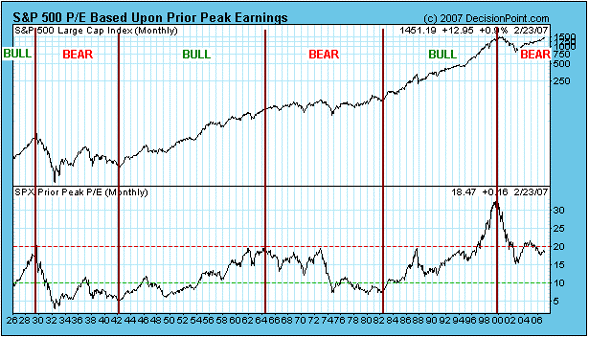|
|||
Sometimes it actually is differentSteve Saville
The "it's different this time" argument will routinely be dragged out in the latter stages of a long-term bull market to justify valuations that simply can't be justified by traditional methods. In the end, however, valuations always revert to their long-term average. In fact, once valuations reach a major peak and reverse course they invariably keep shrinking until they have moved well below their long-term average, at which point a new version of the "it's different this time" argument will typically surface to explain why valuations are doomed to remain low. As a result, investors who buy into the idea that "this time it's different" tend to end up in the poor house. The valuation cycle -- from under-valued to over-valued and back again -- is clearly evident on the following long-term chart of the S&P500's P/E ratio. The secular bull markets for the S&P500 are the 10-25 year periods on the chart when valuations (P/E ratios, etc.) expanded and the S&P500's secular bear markets are the 10-25 year periods on the chart when valuations contracted.  Having said all that, there has been the odd occasion throughout history when, due to a major structural change, it actually was different. For example, in his book "Against the Gods -- the Remarkable Story of Risk" Peter Bernstein explains that prior to 1959 the US stock market's average dividend yield was almost always greater than the yield on long-dated US Government bonds. Furthermore, a drop in the average dividend yield to below the bond yield had traditionally been a reliable indication that stocks were very over-valued and that a substantial stock market correction lay in the not-too-distant future. As a result, many prudent investors would automatically reduce their exposure to the stock market whenever dividend yields dropped below bond yields. However, in 1959 the US stock market's average dividend yield fell below the Treasury bond yield and stayed there. Those prudent investors who exited the stock market in 1959 and began to wait for the S&P500's dividend yield to move back above the bond yield -- something it had always done in the past -- prior to re-building their equity portfolios, are still waiting. The conventional wisdom in 1959 was that stocks should, and invariably did, yield more than bonds because they were riskier, but this age-old relationship was turned on its head by inflation. As an asset class stocks will be riskier than bonds -- and generally yield more than bonds -- in a world where the currency maintains its purchasing power over the long-term. However, in a world where the currency is almost guaranteed to lose its purchasing power at the rate of more than 3% per year there will be a strong tendency for equity yields to be lower than bond yields. The reason is that as prices rise throughout the economy the nominal earnings, and hence the nominal dividend payments, of most companies will also rise. A typical bond, on the other hand, will continue to provide the same nominal income regardless of how much the currency devalues. Now, inflation didn't suddenly emerge in 1959. There was, instead, a multi-decade transition from a stable currency to one that consistently loses its purchasing power. This transition began in 1913 with the creation of the Federal Reserve, took a quantum leap in 1934 with the elimination of US citizens' right to convert their dollars into gold at a fixed rate, and ended in 1971 with the severing of the last remaining official link between the US$ and gold. 1959 just happened to be the year when a critical mass of people came to realise that a knock-on effect of the changing nature of money would be unrestrained growth in the money supply, making bonds inherently riskier than stocks over the long haul. The above-mentioned change in the nature of money also altered other traditional relationships. For example, gold went from being a hedge against deflation to being a hedge against the loss of confidence in the official currency caused by inflation. Despite this there are still plenty of people who buy gold as a hedge against deflation because they have looked at gold's long-term historical record but have failed to account for the major structural changes that have taken place within the monetary system. In doing so they have, over the past several years, proven that in the investment world it is possible for two wrongs to make a right (they were wrong to expect deflation and wrong to expect that gold would do well if genuine deflation did actually occur, but they ended up in the right place anyway because they bought gold). Additionally, the stock market's long-term valuation cycle is clearly still in effect, but the fact that valuations at the end of the most recent secular bull market were more than 50% above those at earlier secular peaks is most likely a consequence of the greater amount of inflation (money supply growth) made possible by changes to the monetary system. Summing up, "it's different this time" is usually a dangerous notion to enter an investor's mind. However, there are rare occasions when relationships that have held without fail for generations suddenly stop working due to major structural changes; and for this reason it can also be dangerous to blindly assume that just because things happened in a particular way in the past they will necessarily happen that way in the future. You really have to understand WHY things happened the way they did in the past before coming to any conclusions about the future. Steve Saville Regular financial market forecasts and analyses are provided at our web site: We aren't offering a free trial subscription at this time, but free samples of our work (excerpts from our regular commentaries) can be viewed at: http://tsi-blog.com Saville Archives |
